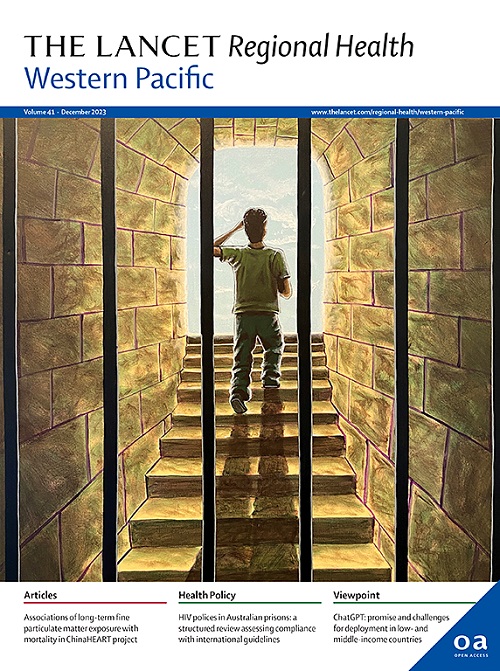香港2型糖尿病患者的生产力调整生命年损失:生命表模型研究
IF 7.6
1区 医学
Q1 HEALTH CARE SCIENCES & SERVICES
引用次数: 0
摘要
背景2型糖尿病在处于黄金工作年龄的年轻人中越来越普遍。我们估计了香港工作年龄人口中患有2型糖尿病的人口水平生产力调整生命年(PALYs)损失。方法构建20 ~ 64岁2型糖尿病患者的生命表,模拟随访至65岁退休。然后,我们重新模拟了相同队列的生命表,假设他们没有糖尿病,调整了死亡率、劳动力参与率和生产率的差异。我们计算了糖尿病相关的PALY损失,并假设每个PALY的成本相当于每个工人的年度国内生产总值(GDP)。2019年,香港工作年龄男性中有6.3% (n = 139,610)和女性中有4.2% (n = 117,670)被诊断为2型糖尿病。在他们的工作生涯中,糖尿病与男性的PALYs减少17.0% (95% ci: 16.9%, 17.1%)和女性的PALYs减少27.8% (95% ci: 27.6%, 28.0%)相关,相当于男性和女性的PALYs分别减少1.0 (95% ci: 1.0, 1.0)和1.1 (95% ci: 1.1, 1.1)。年轻糖尿病患者的人均PALYs损失高于老年人。20-24岁男性和女性因糖尿病每人损失3.9 (95% ci: 3.9, 3.9)和5.0 (95% ci: 5.0, 5.0) PALYs,而60-64岁男性和女性因糖尿病每人损失0.3 (95% ci: 0.3, 0.3) PALYs。总损失的PALYs导致男性GDP损失153亿美元(95% ci: 152、154),女性GDP损失14.5亿美元(95% ci: 144、146)。在香港,2型糖尿病与PALYs和间接经济成本的大幅下降有关,尤其是对女性和年轻人的影响更大。需要有针对性的干预措施来解决这些差异,减轻糖尿病的健康和经济后果的双重负担。香港中文大学直接研究资助。本文章由计算机程序翻译,如有差异,请以英文原文为准。
Population-level productivity-adjusted life years lost in individuals with type 2 diabetes in Hong Kong: a life table modelling study
Background
Type 2 diabetes has become increasingly prevalent in young populations who are in their prime working years. We estimated the population-level productivity-adjusted life years (PALYs) lost in the working-age population with type 2 diabetes in Hong Kong.
Methods
We constructed life tables for individuals aged 20–64 years with type 2 diabetes, with simulated follow-up until retirement at 65 years. We then re-simulated the life tables for the same cohort with the hypothetical assumption that they did not have diabetes, adjusting for differences in mortality rates, labour force participation rates, and productivity. We calculated diabetes-related PALYs lost and assumed the cost of each PALY to be equivalent to the annual gross domestic product (GDP) per worker.
Findings
In 2019, 6.3% (n = 139,610) of men and 4.2% of women (n = 117,670) of working age had diagnosed type 2 diabetes in Hong Kong. Over their working lifetime, diabetes was associated with a 17.0% (95% CIs: 16.9%, 17.1%) reduction in PALYs in men and 27.8% (95% CIs: 27.6%, 28.0%) in women, equivalent to 1.0 (95% CIs: 1.0, 1.0) and 1.1 (95% CIs: 1.1, 1.1) PALYs lost per man and woman, respectively. Younger individuals with diabetes experienced greater per-person PALYs lost than older individuals. Men and women aged 20–24 years lost 3.9 (95% CIs: 3.9, 3.9) and 5.0 (95% CIs: 5.0, 5.0) PALYs per person due to diabetes, compared to 0.3 (95% CIs: 0.3, 0.3) PALYs in both sexes aged 60–64 years. The total PALYs lost resulted in a GDP loss of USD 15.3 (95% CIs: 15.2, 15.4) billion in men and USD 14.5 (95% CIs: 14.4, 14.6) billion in women.
Interpretation
Type 2 diabetes was associated with substantial reductions in PALYs and indirect economic costs in Hong Kong, with disproportionate impacts on women and younger populations. Targeted interventions are needed to address these disparities and mitigate the dual burden of health and economic consequences of diabetes.
Funding
Direct Grant for Research from The Chinese University of Hong Kong.
求助全文
通过发布文献求助,成功后即可免费获取论文全文。
去求助
来源期刊

The Lancet Regional Health: Western Pacific
Medicine-Pediatrics, Perinatology and Child Health
CiteScore
8.80
自引率
2.80%
发文量
305
审稿时长
11 weeks
期刊介绍:
The Lancet Regional Health – Western Pacific, a gold open access journal, is an integral part of The Lancet's global initiative advocating for healthcare quality and access worldwide. It aims to advance clinical practice and health policy in the Western Pacific region, contributing to enhanced health outcomes. The journal publishes high-quality original research shedding light on clinical practice and health policy in the region. It also includes reviews, commentaries, and opinion pieces covering diverse regional health topics, such as infectious diseases, non-communicable diseases, child and adolescent health, maternal and reproductive health, aging health, mental health, the health workforce and systems, and health policy.
 求助内容:
求助内容: 应助结果提醒方式:
应助结果提醒方式:


